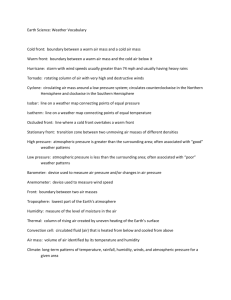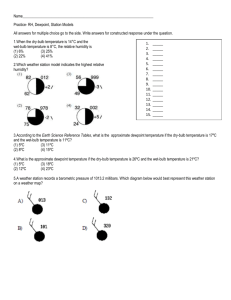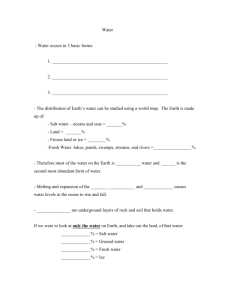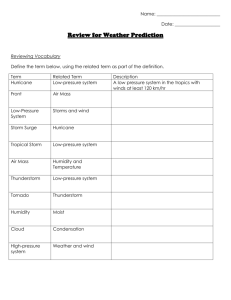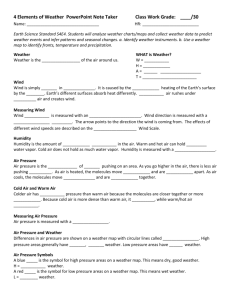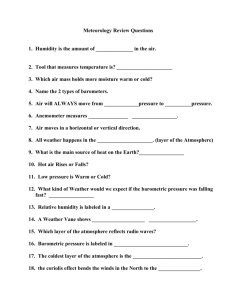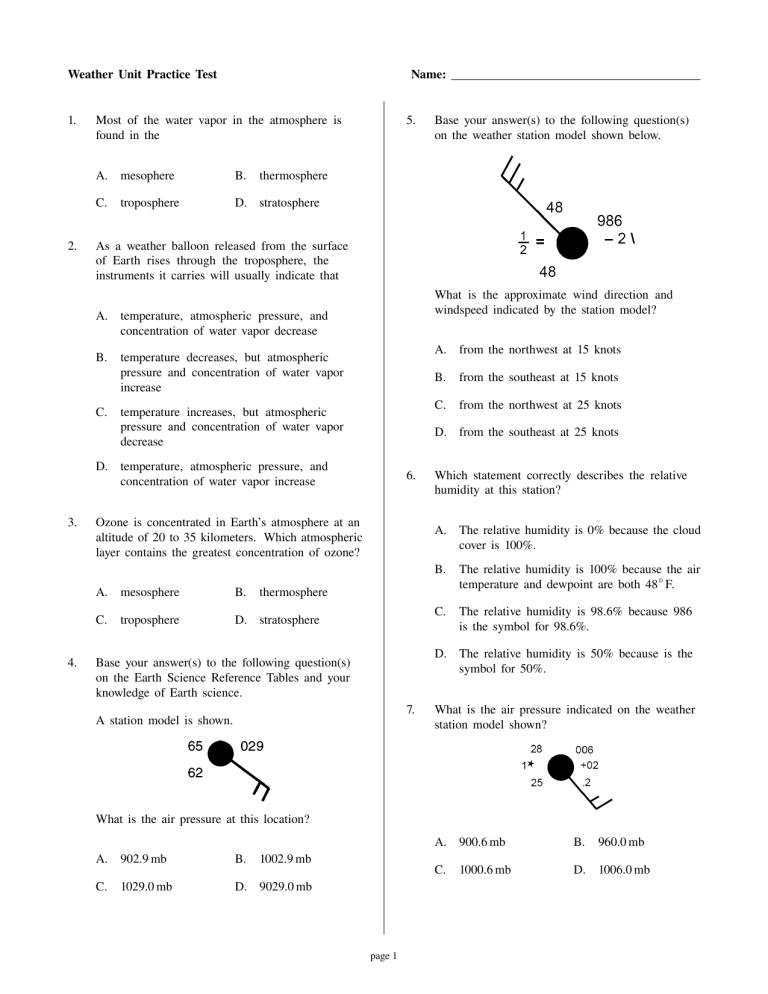
Weather Unit Practice Test 1. 2. Name: Most of the water vapor in the atmosphere is found in the A. mesophere B. C. troposphere D. stratosphere 5. thermosphere As a weather balloon released from the surface of Earth rises through the troposphere, the instruments it carries will usually indicate that A. temperature, atmospheric pressure, and concentration of water vapor decrease B. temperature decreases, but atmospheric pressure and concentration of water vapor increase C. temperature increases, but atmospheric pressure and concentration of water vapor decrease What is the approximate wind direction and windspeed indicated by the station model? 4. 6. Ozone is concentrated in Earth's atmosphere at an altitude of 20 to 35 kilometers. Which atmospheric layer contains the greatest concentration of ozone? A. mesosphere B. C. troposphere D. stratosphere A. from the northwest at 15 knots B. from the southeast at 15 knots C. from the northwest at 25 knots D. from the southeast at 25 knots D. temperature, atmospheric pressure, and concentration of water vapor increase 3. Base your answer(s) to the following question(s) on the weather station model shown below. thermosphere Which statement correctly describes the relative humidity at this station? A. The relative humidity is 0% because the cloud cover is 100%. B. The relative humidity is 100% because the air temperature and dewpoint are both 48 F. C. The relative humidity is 98.6% because 986 is the symbol for 98.6%. D. The relative humidity is 50% because is the symbol for 50%. Base your answer(s) to the following question(s) on the Earth Science Reference Tables and your knowledge of Earth science. 7. A station model is shown. What is the air pressure indicated on the weather station model shown? What is the air pressure at this location? A. 902.9 mb B. 1002.9 mb C. 1029.0 mb D. 9029.0 mb page 1 A. 900.6 mb B. 960.0 mb C. 1000.6 mb D. 1006.0 mb 8. What is the dewpoint temperature when the dry-bulb temperature is 12 C and the wet-bulb temperature is 7 C. A. 9. B. 5 C C. 6 C 6% B. 20% C. 54% The incomplete owchart below shows some of the changes that occur in warm air as it rises to form a cloud. D. 4 C Which statement should be placed in the empty box to accurately complete the owchart? What is the relative humidity when the air temperature is 29 C and the wet-bulb temperature is 23 C? A. 10. 1 C 12. D. 60% Which statement best explains why an increase in the relative humidity of a parcel of air generally increases the chance of precipitation? A. The dewpoint is farther from the condensation point, causing rain. B. The air temperature is closer to the dewpoint, making cloud formation more likely. C. The amount of moisture in the air is greater, making the air heavier. A. The air warms as it expands. B. The air cools until it reaches the dewpoint. C. The air's relative humidity decreases to zero. D. The air enters the thermosphere. 13. Base your answer(s) to the following question(s) on the weather map below. The map shows a low-pressure system that is in uencing weather conditions in New York State. D. The speci c heat of the moist air is greater than the drier air, releasing energy. 11. Base your answer(s) to the following question(s) on the diagram below, which shows the frontal boundary between mT and cP air masses. Wind velocity is probably greatest at which city? A. Bu alo B. Rochester C. Syracuse D. Watertown Why do clouds and precipitation usually occur along the frontal surface? A. The warm air rises, expands, and cools B. The warm air sinks, expands, and warms C. The cool air rises, compresses, and cools D. The cool air sinks, compresses, and warms page 2 Weather Unit Practice Test 14. Which map best represents the direction of surface winds associated with the high- and low-pressure systems? 15. A. Base your answer(s) to the following question(s) on the weather map below and on your knowledge of Earth science. The weather map shows a typical low-pressure system and associated weather fronts labeled A and B. The L indicates the center of the low-pressure system. A few New York State cities are shown. Symbols cP and mT represent di erent air masses. The wind direction at Utica and Rochester is shown on the station models. B. If this weather system is following a normal storm track, the center of this low is most likely moving toward which city? C. A. Bu alo B. Ithaca C. Utica D. Plattsburgh D. page 3 Weather Unit Practice Test 16. Which map shows the most likely path this low-pressure center will follow during the next 12 hours? 18. Base your answer(s) to the following question(s) on the weather map below. The map shows a weather system that is a ecting part of the United States. A. B. The air mass in uencing the weather of Nebraska most likely originated in C. D. the northern Paci c Ocean B. the northern Atlantic Ocean C. central Canada D. central Mexico 19. 17. A. In which geographic region are air masses most often warm with a high moisture content? A. Central Canada B. Central Mexico C. Gulf of Mexico 20. An air mass classi ed as mP usually forms over which type of Earth surface? A. warm land B. C. cool land D. cool ocean Which type of air mass is associated with warm, dry atmospheric conditions? A. D. North Paci c Ocean page 4 warm ocean cP B. cT C. mP D. mT Weather Unit Practice Test 21. The accompanying map shows high-pressure and low-pressure weather systems in the United States. 22. Which cross section best represents the fronts and air movements in the lower atmosphere along line XY? Which two lettered positions on the map are most likely receiving precipitation? A. A and B B. C. C and E D. A and D Base your answer(s) to the following question(s) on the weather map below, which shows a high-pressure center (H) and a low-pressure center (L), with two fronts extending from the low-pressure center. Points X and Y are locations on the map connected by a reference line. B and D A. B. C. D. page 5 Weather Unit Practice Test 23. Which map best shows the most probable areas of precipitation associated with these weather systems? 24. A. Students wish to study the e ect of elevation above sea level on air temperature and air pressure. They plan to hike in the Adirondack Mountains from Heart Lake, elevation 2,179 feet, to the peak of Mt. Marcy, elevation 5,344 feet. Which instruments should they use to collect their data? A. anemometer and psychrometer B. anemometer and barometer C. thermometer and psychrometer D. thermometer and barometer B. C. D. page 6 Weather Unit Practice Test Problem-Attic format version 4.4.374 c 2011–2018 EducAide Software _ Licensed for use by Mr White Terms of Use at www.problem-attic.com Weather Unit Practice Test 1/9/2020 1. Answer: Points: C 1 15. Answer: Points: D 1 2. Answer: Points: A 1 16. Answer: Points: D 1 3. Answer: Points: D 1 17. Answer: Points: C 1 4. Answer: Points: B 1 18. Answer: Points: C 1 5. Answer: Points: C 1 19. Answer: Points: D 1 6. Answer: Points: B 1 20. Answer: Points: B 1 7. Answer: Points: C 1 21. Answer: Points: B 1 8. Answer: Points: A 1 22. Answer: Points: C 1 9. Answer: Points: D 1 23. Answer: Points: C 1 10. Answer: Points: B 1 24. Answer: Points: D 1 11. Answer: Points: A 1 12. Answer: Points: B 1 13. Answer: Points: C 1 14. Answer: Points: C 1
